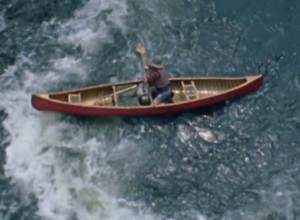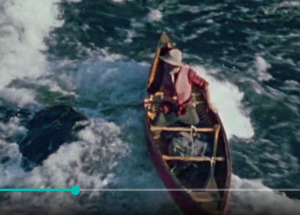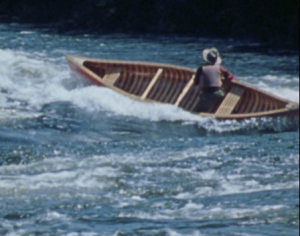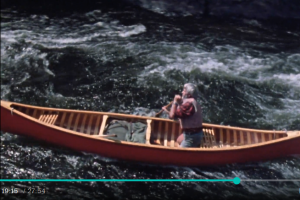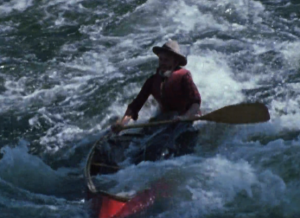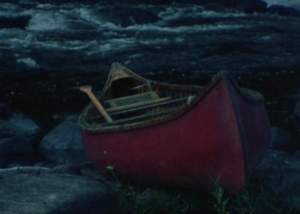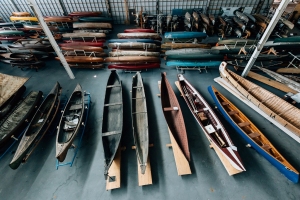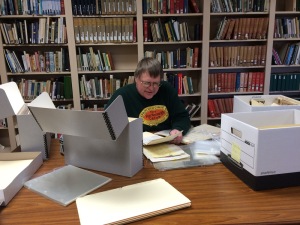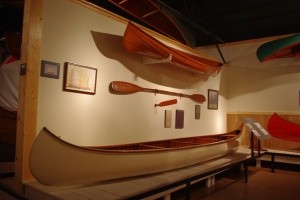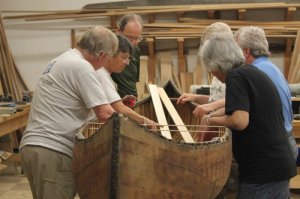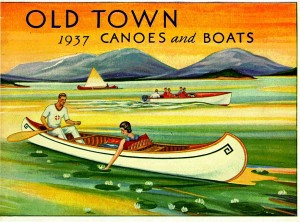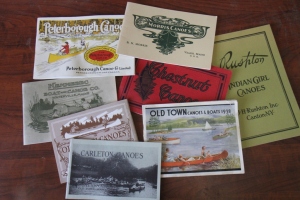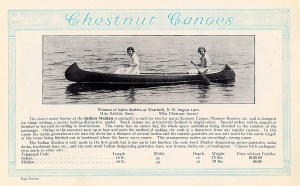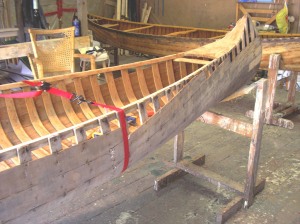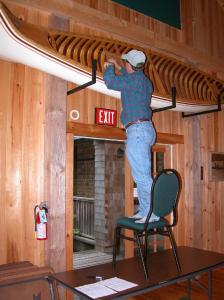by Mike Elliott, Kettle River Canoes
email: artisan@canoeshop.ca
The National Film Board of Canada (NFB) website is a treasure trove of beautiful short films. Among my personal list of favourites is the Path of the Paddle series by Bill Mason. Of the four films in the series, Path of the Paddle Solo Whitewater (1977) is the one I tend to watch over and over again. Not only is the photography outstanding, I get a thrill every time I see a wood-canvas canoe being jockeyed through 3′ (one meter) standing waves in a wild river.
The canoe featured by Bill Mason in the film is a Chestnut Pal (16′ pleasure canoe). Its gorgeous lines, distinctive red colour and hand-woven cane seats gives the film a touch of class.
One of my favourite occupations while watching any film, is looking for and finding continuity glitches. In this one, Bill navigates his Chestnut Pal through a particular set of rapids. Meanwhile, the canoe is alternately being paddled empty and then is loaded with canoe packs — switching back and forth as if by magic.
I enjoy watching the Chestnut Pal handle challenging rapids with grace and style. For a general-purpose canoe that is 12.5″ (32 cm) deep with a 36″ (92 cm) beam, its ability to handle these conditions is impressive. That said, I like to keep in mind that Bill was able to run the same section of river many times and select the runs that worked out (the key to good story-telling is good editing).
For anyone unfamiliar with wood-canvas canoes, this film is an education in just how durable they are. I love watching Bill bumping and thumping off rocks in his Chestnut Pal. Especially impressive is one sequence where the canoe hits an exposed boulder broadside in the river and lives to tell the tale.
Bill plays fast and loose with cinematic continuity during a sequence discussing how to handle the canoe in high-water conditions. We watch him start into a class 3 rapid in his Chestnut Pal (note the hand-woven cane seat).
Then, the canoe miraculously survives a near upset. Indeed, this would have been a miracle if Bill was paddling his Chestnut Pal. However, a closer look reveals that the canoe capable of handling this situation is not a Chestnut Pal but rather a Chestnut Prospector (16′ wilderness tripping canoe) that is 14.5″ (37 cm) deep — note the all-wood slat seats.
The Chestnut Prospector is perfectly designed to handle class 3 rapids. The extra depth keeps the water out of the canoe as does the fact that the hull is flared (V-shaped) about 4′ (1.2 meters) from each end. Bill painted all of his canoes the same colour in order to allow him to interchange them during filming.
The photography in these films is absolutely stunning. The image of a red canoe on the water has become a major part of Canadian iconography due in no small part to Bill Mason and his use of red Chestnut canoes in his films.
The Chestnut Pal is one of the best general-purpose canoes ever designed. However, it is not designed to handle class 3 rapids. Apparently, that did not stop Bill Mason from trying. I applaud him for showing us the limits of this amazing canoe.
I encourage you to make your way to the NFB website and check out the Path of the Paddle films by Bill Mason. They are, for me, well worth the time and effort.
How to Get Information About Your Old Wooden Canoe
June 24, 2018
by Mike Elliott, Kettle River Canoes
email: artisan@canoeshop.ca
Fundamental to any canoe restoration is understanding what you are dealing with. This blog examines a number of ways to answer some basic questions:
1) Who built my canoe?;
2) When was it built?;
3) How was it built?;
4) What supplies and materials were used? and;
5) What did it look like originally?
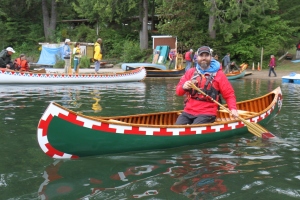
Mike Wootton asked the WCHA about his Old Town canoe. It was built in 1937 and was shipped to Portland, Maine. The decks, thwarts and seats are oak, the gunwales are spruce and the canvas was painted dark green. He added the Old Town design number 1 as a finishing touch. He then showed it off at the 2016 spring meet of the Northwest Chapter of the WCHA.
WCHA – The first place I go for information about a new restoration project is the Wooden Canoe Heritage Association (http://www.wcha.org). They are an amazing resource. One of the things they do is to host an on-line forum. When you ask a question, there are often several people quick to respond with help, advise, guidance and historical information.
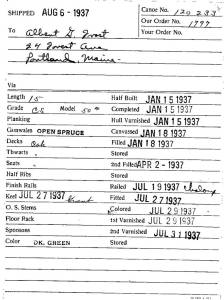
Mike Wootton asked the WCHA about his Old Town canoe (serial number 120233). They sent him a scan of the original build record. He used the information to complete the restoration.
Part of the forum is a build record search. They have archived a complete collection of Old Town, Carleton and Kennebec canoe company build records. If you have the serial number from your canoe, they will send you a scan documenting when it was build, the model, colour and style as well as to whom it was shipped.
Canoe Museums – The Canadian Canoe Museum in Peterborough, Ontario houses a collection over 600 vintage canoes and kayaks from around the world.
In addition, they house a large archive of canoe-related documents. It is worth becoming a member and spending the time to dig through their collections for the information you are looking for.
Another source of information is the Wisconsin Canoe Heritage Museum in Spooner. It has a small, yet comprehensive collection of primarily American-built antique canoes.
Both of these museums include workshop facilities and run regular classes teaching canoe restoration techniques. They can also connect you with canoe restorers who have experience dealing with specific types of antique canoe.
It is also worthwhile to venture into every small museum and gallery you come across in your travels. Old canoes often create a focal point in community collections. When you find a canoe you are looking for, ask the curator for permission to measure the canoe and take notes on its construction.
On-Line Searches – Once you know the make and model of your canoe, it is often helpful to enter those words into on-line search engines. You never know what may happen to be available for a week or two. Written articles, blog posts and images from boat shows (to name a few) will be available on-line for a limited time. Check on a regular basis to see what is newly posted. Also, see what is being sold on ebay. There may be a listing for exactly the same canoe you are working on. Canoe catalogues are also sold regularly on ebay. If your canoe is an Old Town, and you known the year it was built, it is possible that the catalogue for that year is being sold on-line.
Catalogues – As you begin to plan your restoration, the canoe catalogue for your make, model and year can often provide a wealth of specific information about how your canoe was constructed, the woods used for the various components and perhaps examples of decorative designs painted on the canvas.
The WCHA has developed an impressive collection of historic canoe company catalogues for sale. From their on-line store, you can buy reprints of a wide variety of vintage canoe company catalogues (both Canadian and American). Large collections are also available on USB memory drives. These include: 1) a collection of 73 catalogues from 12 Canadian companies; 2) a collection of 50 Canadian and American companies; 3) a collection of every page of every Old Town Canoe Company catalogue from 1901 to 1993 and; 4) a collection of Thompson Brothers catalogues from 1907 to 1970.
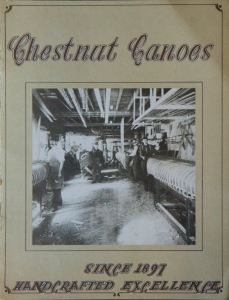
The front cover of the 1978 catalogue for the Chestnut Canoe Company. My client designed the catalogue which turned out to be the last one ever produced.
The Last Chestnut (How research helped bring a canoe back to life) – In 2006, a client came to me with his Chestnut canoe which was in desperate need of restoration. He designed the 1978 catalogue for the company. When asked what he wanted in terms of payment, he requested they build an Indian Maiden canoe for him.
It had been almost 20 years since they last built that model. They found the building form buried in mud behind the factory. They rebuild it and decided to build a special edition series of 300 canoes. They worked out the process by building a prototype and then built the canoe for my client (a special plaque on the bow identifies it as 001 of 300). He took possession of the canoe directly from the factory in December 1978 and they closed the doors behind him. They were out of business.
When the canoe arrived in my shop, many components were missing and I had never seen another like it. In an on-line search, I found an article from the University of New Brunswick talking about a canoe that had been hidden away in the basement of a building on campus. The article identified it as a Chestnut Indian Maiden built in 1978. The university had just donated the canoe to the Wild Salmon Nature Centre in St. Andrews by-the-sea, NB.
My sister and her husband live in Maine about two hours drive from St. Andrews. I told them about my project and asked them to collect dimensions for a number of components on the canoe. They readily agreed and took on the research project as only two wildlife management PhD’s can. A couple of weeks later, I received a package full of photos, measurements, drawings and notes.
My restoration concluded successfully thanks to lots of research.
After publishing the story, I received an email from someone in Toronto. His brother had seen the Indian Maiden on display at the Canadian National Exhibition in the fall of 1978. Apparently, he was the only person to order one. The plaque on the bow identifies it as 002 of 300. To my knowledge, it is the last canoe ever built at the factory.
The entire canoe restoration process is described in my book – This Old Canoe: How To Restore Your Wood Canvas Canoe.
If you live in Canada, CLICK HERE to buy the book.
If you live in the USA, CLICK HERE to buy the book.
If you live in the UK, CLICK HERE to buy the book.
Si vous habitez en France, CLIQUEZ ICI acheter le livre.
The Evolution of Factory-Built Wooden Canoes
June 17, 2018
by Mike Elliott, Kettle River Canoes
email: artisan@canoeshop.ca
Fundamental to any canoe restoration is understanding what you are dealing with. The scope of this blog is limited to factory-built wooden canoes held together with metal fasteners. More recent types of wooden canoe construction employing materials such as glue, fiberglass, resin, etc. will not be included. This blog presents a rough guide to the form and structure of factory-built wooden canoes and the ways in which they developed and diversified over time.
Since this blog concerns itself with the repair and restoration of antique canoes, I will not enter into an academic examination of canoe history. For that, I refer you to such books as: Canoecraft by Ted Moores and Merilyn Mohr (1983); The Wood & Canvas Canoe by Jerry Stelmok and Rolin Thurlow (1987); The Canoe: A Living Tradition by John Jennings (2002) and; Canoes: A Natural History in North America by Mark Neuzil and Norman Sims (2016). Instead, I will present the evolution of factory-built canoes with an emphasis on the variety of construction methods employed.
Dubbed Copper Nail Construction
In Ontario, Canada in the mid-1800’s, a number of boat builders in the region in and around Peterborough were experimenting with canoe construction methods. Their ideas were influenced by the dugout canoes in the region. They built their canoes over a solid wood form (perhaps using a dugout canoe as the basic shape). They employed many building techniques borrowed from European boatbuilding traditions to create all-wood canoes with no exterior waterproof cover.
Rib-and-Batten – By 1859, John Stephenson and Tom Gordon were producing canoes using a ‘rib-and-batten’ method. A keelson (usually made of white oak) is set into the form. Notches are cut along the length of the keelson (at 4½” or 11.4 cm centres) into which half-round rock elm ribs (about 5/8″ or 16mm wide) are set and steam-bent over the form. Wide-board planks (made of basswood or Spanish cedar) are bent over the form on top of the ribs and are held in place with 16-gauge copper nails. Pilot holes are drilled through the planks and ribs. Then, the nails are driven straight into the solid wood form. Once this is done for the entire canoe, it is pulled off the form and turned right-side up. A chunk of iron shaped specifically for the purpose (called a dubbing iron) is used to bend the nails along each rib with the points oriented toward the keelson in a process called ‘dubbing over’. The dubbing iron is then used as backing against each rib while each nail is hammered flat into the wood with a cobblers hammer. The wide-board planks run longitudinally the length of the canoe and are placed against each other with butt joints. These joints are covered with battens on the interior which are also attached with dubbed copper nails. ‘Labour-intensive’ is a mild way of describing this process. A 16′ (4.9 meter) canoe is held together with approximately 4,000 nails.
Cedar Rib – In 1879, John Stephenson patented the ‘cedar-rib’ canoe construction method. White cedar ribs are steam-bent over a solid wood form and are fitted tightly together with tongue-and-groove joints. Once completed, the canoe is disassembled in order to remove it from the form. It is then reassembled and held together with a number of stringers running longitudinally. The stringers are attached to the ribs with copper nails which are dubbed over and flattened in the usual fashion. As we looked at one of these canoes at the Canadian Canoe Museum, Jeremy Ward, the museum curator, said, “I want to build one of these just to prove it can’t be done.”
Longitudinal Strip – John Stephenson continued his design efforts with a third construction method patented in 1883. This method starts by bending the half-round rock elm ribs over the solid wood form at 3″ (76 mm) centres (notched into the keelson). Then, longitudinal strips of edge-grain white cedar are placed on top of the ribs and are fitted together with shiplap joints. These strips are 2″ (51 mm) wide in the centre of the canoe and are tapered by hand to about 1¼” (32 mm) at the ends. Again, dubbed copper nails are used to hold the entire canoe together. Over time, this method emerged as the standard for what became known as the “Peterborough” canoe.
Flush Batten – The rib-and-batten method was refined by William English with the introduction of his patented ‘flush batten’ construction method in 1888. His method begins in the usual way with half-round rock elm ribs steam-bent over a solid wood form (notched into the keelson at 4½” or 11.4 cm centres). Wide, white cedar planks with rabbeted (rebated) edges run longitudinally on top of the ribs. Thin rock elm battens are set into the channels formed by the rabbeted edges. These battens sit flush with the interior edges of the planks. As usual, the entire canoe is held together with dubbed copper nails. This construction method was widely used in racing canoes.
**************
All of these construction methods rely on expert craftsmanship and tight joints to produce watertight canoes. Once it has been sitting in water for a day or two, the wood in the canoe swells and the joints become very tight indeed. That said, a large sponge is a standard piece of equipment in these canoes.
Clinched Tack Construction
Double-Plank – Dan Herald was another of the inventive canoe builders in the Peterborough region of Ontario. He patented his ‘double-plank’ construction method in 1871. This method employs a solid wood form sheathed with metal. White cedar planks are steam-bent transversely (from one side of the canoe to the other) and are fitted together with butt joints. Next, cotton muslin or canvas soaked in pine tar is laid on top of the first layer of planks. The treated cloth helps waterproof the canoe. The next step in this method is to place a second layer of thin, white cedar planks onto the form. These planks run longitudinally and are attached to the first layer of planks with small, thin copper tacks (later simply referred to as ‘canoe tacks’). The tacks are driven into the wood with a cobblers hammer. They hit the metal sheathing on the form and curl back on themselves to clinch the wood together.
Capped Gunwale – A number of salmon fishing guides and canoe builders lived and worked along the Penobscot River in Maine in the late 1800’s. They worked with and often built birch bark canoes. They had become used to using canvas (waterproofed and painted) to cover their canoes and keep them watertight. It appears they heard about Dan Herald’s double-plank construction method in the mid- to late 1870’s and started adapting his ideas to create canoes emulating the birch bark canoes in their region. They began building their canoes over solid wood forms sheathed with strips of metal. White cedar ribs (about 2″ or 51 mm wide and 5/16″ or 8 mm thick) are steam-bent over the metal strips on the form. No keelson is used since birch bark canoes do not employ this feature. White cedar planks run longitudinally on top of the ribs and are fitted together with butt joints. The planks and ribs are held together with copper canoe tacks that clinch when they hit the metal strips upon which each rib is bent. The ends of the ribs are attached to hardwood (usually ash) inwales – another feature of birch bark canoes. To emulate the look of bark canoes, the ends of the ribs are either tapered and attached against a chamfered edge of the inwale or they are set into pockets carved into the inwale (usually with a forstner bit). Once most of the canoe is completed, it is removed from the form and turned right-side up. Then, the stems and decks are installed and the hull construction is completed. Canvas is then stretched over the hull and held in place with canoe tacks. Next, the canvas is waterproofed with a canvas filler and trimmed along the sheer-line. The look of a bark canoe is completed with the attachment of thin hardwood caps on top of the inwales and thin hardwood outwales used to cover the top edge of the canvas. Evan H. Gerrish has been acknowledged as the first canoe builder in Maine to use this method. Others quickly followed. Among them were Edward M. White, Bert N. Morris and Guy Carleton.
Double Gunwale – By the 1890’s, the look of the gunwales was refined with the development of the ‘double gunwale’ system. The tops of the ribs are still set into pockets in the inwales but the gunwale-cap is no longer used. Instead, the outwales are widened to look very much like those found on canoes built in Ontario. This results in a very elegant look to the gunwales.
Open Gunwale – Bark canoes are held together with tension as the ribs are hammered into place thus wedging the rib-tops between the inwales and outwales. Each fall, the ribs are hammered out of position and the canoe is stored away for the winter. In factory-built canvas-covered canoes, the rib-tops are held permanently inside pockets cut in the inwales. Over time, water is held in the pockets and the moist environment is perfect for the growth of the fungi that cause wood rot. Around 1905, builders developed the ‘open gunwale’ system. This allows water to drain quickly from the canoe and keep the rib-tops rot-free for a longer time. By the mid-19-teens, the entire canvas-covered canoe industry had adopted this system.
The entire canoe restoration process is described in my book – This Old Canoe: How To Restore Your Wood Canvas Canoe.
If you live in Canada, CLICK HERE to buy the book.
If you live in the USA, CLICK HERE to buy the book.
If you live in the UK, CLICK HERE to buy the book.
Si vous habitez en France, CLIQUEZ ICI acheter le livre.
The Canoe – A Short Film Written and Narrated by James Raffan
February 25, 2018
by Mike Elliott, Kettle River Canoes
email: artisan@canoeshop.ca
I recently came across a short film called The Canoe. It was released last year (2017) and is written and narrated by James Raffan (author, director emeritus of the Canadian Canoe Museum). Running 27 minutes, this short film examines the role of the canoe in shaping the lives and life connections of several people. It opens with a voice-over narration by James Raffan as we watch him paddle a beautiful old Chestnut Pal (Deer) canoe over calm, misty water.
The Connector – The first profile in the film is of Michelle Savoie. She comes from a long line of canoe people tracing back to the voyageurs. She and her family see the canoe as the connecting force in their family.
The Champion – Alexandra McGee is an elite-level competitor in white-water slalom canoeing. The discipline and focus required to become a champion helped her overcome many personal challenges.
The Explorers – Gary and Joanie McGuffin are authors, photographers, educators and explorers. They have used canoes to create a life together that is full of wonder and beauty. They find something new around every bend in the river.
The Settler – Michael Zhang left a hectic life in China to create a life in Canada full of joy and peace. He and his family find that joy and peace every time they get out on the water in their canoe.
The Mentor – Gail Bannon helped the young people in the Fort William First Nation reconnect with their culture and heritage by teaching them how to build a birch bark canoe.
I hope you enjoy this film – I certainly did. For me, it brought into sharp focus the truth about canoes. They are a powerful cultural linchpin in the Canadian identity. The canoe is an essential part of our sense of self, sense of family and sense of community. Enjoy.
A Call for Your Old Town Canoes at the 2018 WCHA Assembly
February 18, 2018
by Mike Elliott, Kettle River Canoes
email: artisan@canoeshop.ca
If you are planning on bringing an Old Town canoe (or six) to the 2018 Wooden Canoe Heritage Association Assembly at Trent University this July, please contact me via email (artisan@canoeshop.ca).
I am writing This Fancy Old Canoe: A Collector’s Guide To Restoring Antique Canoes. It is a companion to my first book (This Old Canoe: How To Restore Your Wood-Canvas Canoe) and will focus on Old Town Canoes.
Chapter 12 of this book will describe various models of Old Town Canoes. I want to photograph them on the water at first light (or at dusk). I am hoping to get pictures of an OTCA, a Yankee, an HW, a Guide, a Charles River and a 50-pound model. If you would like to see your canoe in my next book, please contact me to arrange the photo shoot.


